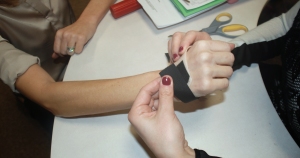
Cubital Tunnel Syndrome is the second most common nerve compression, caused by increased pressure on the ulnar nerve at the elbow. The people, who repeatedly lean on their elbows or bend their elbows for sustained periods, are more likely to get affected by this condition. This condition is more common in men than women.
What do you mean by Cubital Tunnel Syndrome?
Cubital Tunnel Syndrome affects ulnar nerve where it crosses the inside edge of the elbow. This inside edge is relatively unprotected area and ulnar nerve here is entrapped between bone and skin in the tunnel called ‘Cubital Tunnel’. When the ulnar nerve in the cubital tunnel gets compressed or irritated due to an injury or pressure, it called cubital tunnel syndrome. This condition affects the Baseball Pitchers more, as the twisting motion used to throw a slider can easily damage ligaments in their elbow.
What are the common causes of Cubital Tunnel Syndrome?
Cubital Tunnel Syndrome can occur due to following possible reasons:
- Sustained bending of elbow during sleep
- Leaning over your elbow for longer time
- Fluid build-up in the elbow
- A direct blow to inside edge of the elbow
- Previous fracture, injury or dislocation of the elbow
- Arthritis of elbow or bone spurs
- Any cyst near the elbow
- Repetitive bending, twisting or flexion of elbow during painting, playing an instrument or using power tools
- Obesity or other health conditions like hypothyroidism or diabetes
What are the potential signs and symptoms of Cubital Tunnel Syndrome?
Typical symptoms of Cubital Tunnel Syndrome may include:
- Numbness and tingling sensation or intermittent pain in the elbow
- Pain in the elbow extending to your forearm and hand
- Weakness in hand and fingers
- Being unable to straighten your ring and little finger
- Tenderness in the inside edge of the elbow
- Difficulty in gripping and holding the objects
- Reduced ability to pinch the thumb and little finger
- Claw-like deformity of the hand
How can physical therapy help to treat Cubital Tunnel Syndrome?
Physical therapy treatment for Cubital Tunnel Syndrome includes patient education along with identification, modification and limiting the causes resulting into nerve inflammation. Apart from this, physical therapists may suggest:
- Ergonomic considerations and changes in patterns of activities causing the condition
- Specific elbow padding may be provided for work and leisure activities as well
- Splinting at night may be suggested to limit range of motion enhancing the compression
- Ulnar gliding exercises and modalities are practiced to relieve the painful symptoms
- Modification of job activities, if needed, may be suggested
- Therapists will suggest you different ways to rest your elbow and also educate you about the ways to use your elbow without putting any extra strain in it.
- Heat or cold treatments may be applied to ease the pain
- Strengthen and stretching exercises are used to strengthen the muscles of the forearm
- Range-of-motion exercises are used to help you to return full length of muscles that are shortened due to protective posturing
Contact Active Physical Therapy for the state-of-art treatment of any of your musculoskeletal problems. Our certified ad dedicated physical therapists design individualized treatment plans depending upon your condition and problem.